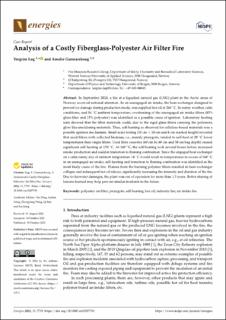| dc.description.abstract | In September 2020, a fire at a liquefied natural gas (LNG) plant in the Arctic areas of Norway received national attention. In an unengaged air intake, the heat exchanger designed to prevent ice damage during production mode, was supplied hot oil at 260 °C. In sunny weather, calm conditions, and 14 °C ambient temperature, overheating of the unengaged air intake filters (85% glass fiber and 15% polyester) was identified as a possible cause of ignition. Laboratory heating tests showed that the filter materials could, due to the rigid glass fibers carrying the polymers, glow like smoldering materials. Thus, self-heating as observed for cellulose-based materials was a possible ignition mechanism. Small-scale testing (10 cm × 10 cm and 8 cm stacked height) revealed that used filters with collected biomass, i.e., mainly pterygota, tended to self-heat at 20 °C lower temperatures than virgin filters. Used filter cassettes (60 cm by 60 cm and 50 cm bag depth) caused significant self-heating at 150 °C. At 160 °C, the self-heating took several hours before increased smoke production and sudden transition to flaming combustion. Since the engaged heat exchanger on a calm sunny day of ambient temperature 14 °C would result in temperatures in excess of 160 °C in an unengaged air intake, self-heating and transition to flaming combustion was identified as the most likely cause of the fire. Flames from the burning polymer filters resulted in heat exchanger collapse and subsequent hot oil release, significantly increasing the intensity and duration of the fire. Due to firewater damages, the plant was out of operation for more than 1.5 years. Better sharing of lessons learned may help prevent similar incidents in the future. | en_US |

